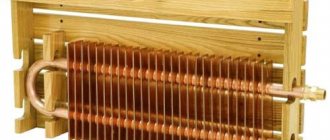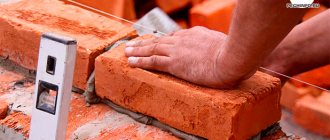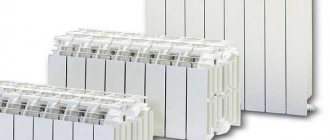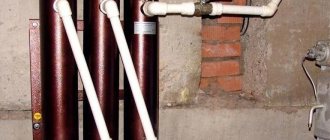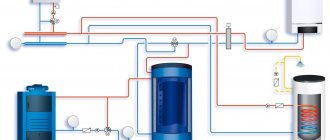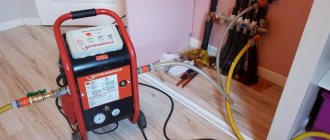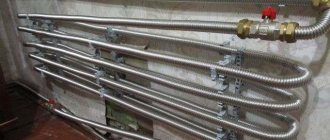During the cold season, residents often complain about problems with heating appliances. The radiators heat weakly or partially, so the air temperature in the apartment is below normal. What to do in such a situation?
Let's consider a way to improve the situation, correct a situation that brings discomfort and unnecessary costs, namely a heating radiator flow extender .
- What is a flow extender
- Where are flow extenders installed?
- Review of popular brands
- How to make it yourself
- Installation features
Purpose of the flow extender
Most often, a flow extender is used when connecting radiators to the side.
The part is used to change the direction of flow of the coolant, which allows the battery to heat evenly without reconnecting. The duct extension is suitable for radiators connected from one side. Often it is installed on a reverse connection, due to which water moves diagonally.
Typically, the part is used for long batteries (the number of cells is more than 10), since their design contributes to uneven heating. The further the section is from the tube through which the water is supplied, the more likely it is that it will remain cold. The easiest way to fix this is to install an extension cord. This will help ensure even and efficient circulation. The device is suitable for bimetal batteries (with aluminum and steel components). It is rarely used for cast iron structures.
Installation
Sgony
Here are instructions for connecting a cast-iron battery to squeegees.
- We push the locknuts and the passage plug onto the long threads of the liner until they stop.
- We hang the radiator by inserting the liner threads into the first section by 1-3 centimeters.
- We wind the plug along the thread with a bunch of plumbing flax with paint or silicone pipe sealant.
- We wrap it into the radiator until it stops with moderate force.
- We drive the locknut to the plug, leaving a gap of 5 - 10 mm between them.
- We wind a bunch of flax into the remaining gap along the thread (again with paint or sealant).
- Tighten the locknut.
The cast iron battery is connected to the leads.
American women
Here the procedure is much simpler:
Let's look at the Americans; We screw the parts of the fittings with the union nut into the coupling, tap or throttle, and the elements with the gasket into the radiator plugs
For winding we use the same flax with paint or a polymer thread - sealant. We hang the radiator on the brackets. We screw on the American union nuts by hand and carefully, without unnecessary effort, tighten them with an open-end or adjustable wrench.
Excessive force will tear the gasket or crush the American nut.
Pros and cons of using
You can make a flow extender with shut-off valves yourself or buy it in a store.
The main advantages of the device are ease of installation and increased efficiency of the heating system. To purchase it or make it yourself, you will not need serious financial investments. To install the device, it is enough to have basic plumbing skills. Increased productivity is achieved without adjusting the existing battery connection diagram.
The duct extension for a bimetallic radiator has certain restrictions on its use. It can only be installed on radiators connected one-sided on the right or left side. They must also be equipped with shut-off fittings on the return and water supply sides. If this is not the case, you will not be able to install the fitting. You will have to contact a specialist and reconnect, which requires a lot of labor.
Ready-made extension cords are quite rare in stores, but they are easy to make yourself or order online.
How to choose a squeegee
When choosing a drive, you need to consider:
- type of connecting fitting;
- fitting material;
- technical specifications.
Types of surges
Surges can be classified according to the following criteria:
- Depending on the design, they are distinguished:
- direct drive, intended for installation on a flat section of the highway (figure above);
- corner bend, intended for areas where it is necessary to change the direction of the pipeline system;
Fitting for changing the direction of the line
Straight and angular bends differ solely in appearance and purpose. All other parameters are completely identical.
- depending on the scope of application there are:
- compensating surges. In most cases, such devices are installed in places where plumbing or gas equipment and heating radiators are connected, as they allow compensation for pipe deviations within 5 cm;
- short and long runs used to connect other equipment of the pipeline system.
Types of pipe runs
Many people, especially novice plumbers, consider fittings such as barrels and threads to be types of fittings. However, this statement is wrong.
A barrel is a piece of pipe with threads at the ends. Unlike a bend, threads of the same length and size are applied to the pipe on both sides. This device is intended for connecting pipes without welding.
Fitting for connecting pipes to each other
A thread is a fitting made from a section of pipe with a thread on one end. The device is used to connect other types of threaded fittings to a water supply, gas or heating system.
Device for installing threaded fittings
Selection of manufacturing materials
For the manufacture of squeegees, the following materials are used:
- carbon steel. Steel fittings are characterized by low cost and a large margin of safety. However, due to their strong susceptibility to corrosion, their installation is carried out mainly on gas supply systems;
- Cink Steel. Such fittings are not subject to the formation of a corrosive coating, therefore they can be used in water supply systems, including drinking water supply and heating, as well as on other pipelines in places subject to possible exposure to precipitation;
- stainless steel. Unlike galvanized stainless steel fittings, they are more expensive and are primarily intended for drinking water supply systems, as well as for connecting pipes in the ground;
- brass. Currently, due to its high cost, it is practically not used.
Brass squeegee for pipelines
Determination of technical parameters
Metal bends are manufactured in accordance with GOST 8969-2010. When selecting parameters, you should consider:
- type of thread. The bends can be with left-hand thread or right-hand thread, with internal thread or with external thread. The selection of this parameter is carried out based on the data of the equipment that needs to be connected using a fitting;
- nominal diameter of the fitting in accordance with the diameter of the pipeline;
- the size of the thread applied to the fitting.
Standard dimensions of metal pipes in accordance with GOST
All technical parameters are indicated in the fitting marking, which is applied in accordance with GOST 8969-75. For example, Sgon40-Ts GOST 8969-75 indicates that the fitting is made of galvanized steel (Ts) in accordance with technical regulations and has a nominal bore of 40 mm.
Source
Features of the extension cord
The main components of a flow extender for a heating radiator are a small fitting (0.5 or 0.75 inches) and a tube connected to it. The latter can be made of different materials - stainless steel, copper, polyethylene or plastic. Copper tubes cannot be used in conjunction with aluminum radiators and parts: when interacting, these metals oxidize. The part mounted on the reverse connection changes the direction of movement of the coolant so that maximum efficiency is achieved. This method will be effective for long radiators (0.8 m or more).
Bottom liner options
There are only two of these, let’s get acquainted with the features of each of them.
Table. Bottom pipe options.
| Name, photo | Short description |
| One-sided | In this case, both pipes are connected on one side. The hot coolant enters through the top plug, and the cooled coolant is discharged through the bottom. |
| Versatile | The entrance and exit, as you might guess from the name, are on different sides. This connection option is ideal for individual heating systems. The good thing about this option is that hot water can flow in any direction, plus the length of supply and return is shorter here. |
DIY extension cord
When making it yourself, it is better to use a copper pipe.
It is not difficult to make such a design yourself if you have all the required components and a suitable type of battery connection. The valves through which the radiator is connected must be ball-type and equipped with American valves. They need to be shut off and the water drained. Then you can begin installation work.
Procedure:
- On one of the sides there is an upper footer. It must be unscrewed together with the detachable fastening element mounted there. This must be done carefully so as not to damage the paint coating. Then it is advisable to replace the silicone round. You can completely dismantle the heating battery if this seems more convenient for work.
- Proceed directly to the assembly of the extension structure. The tube cut with a special tool will need to be soldered to the sleeve. First, it is cleaned from the inside from plaque and dirt using a brush. Solder fat works well as a flux. Using a small brush, it is applied on top of a part that has a smaller diameter. Then one element is inserted into the other and the excess fat is wiped off. The joint area begins to be heated with a burner until a silvery tint appears.
- After this, solder is applied to it. If heating is performed correctly, the solder softens from the high temperature, flows into the joint area and fills the space. When this happens, you need to wait at least a minute until the molten metal completely hardens.
- The American one with cleaned inner walls has a diameter of 1.9 cm. The coupling has a slightly larger diameter. You can use a small file to remove excess. This must be done carefully so as not to damage the parts. For driving, you can use wooden spacers.
- Sometimes you have to experiment with the length of the tube. Sometimes the optimal length is to the middle of the radiator, but it is preferable to start with a longer one. If necessary, excess length can be cut off later.
The extension device is mounted in the hole and screwed. You also need to replace the gasket and the battery itself. A Mayevsky crane is used to remove air masses from the system.
Required tools and materials
Installing a flow extension into a radiator
You need to select a piece of pipe that will serve as an extension. The thickness of its walls should be at least 1 mm, and the cross-section should be 1.8 cm. The length is taken approximately equal to the length of the heating radiator itself. If necessary, it can be shortened in the future. It is important not to forget about the ban on installing copper elements in the same structure with aluminum ones (including bimetallic radiators with parts made of this metal). Ignoring this rule is fraught with the destruction of all reacting parts of the system.
For installation you will also need to prepare the following parts and tools:
- Straight coupling for soldering with an outer diameter of 2 cm.
- A pipe cutter that allows you to evenly cut a piece of extension to the required length without deforming the metal. When working with this tool, the workpiece is held at a right angle. Once the trimming is complete, you can use a brush to remove any uneven areas.
- Bevel remover. With its help, burrs are eliminated in places adjacent to the ends of the tube segment.
- A metal brush and a stiff brush.
- Device for expanding pipes.
- Solder.
- Soldering torch. A simple device of small dimensions will do; you can fill it with gas used for lighters.
The silicone gasket installed in the connection should also be replaced with a fresh one.
Restoring the functionality of the heating device
Let's figure out how to make an extension cord. First you need to stock up on the following materials and tools:
- solder coupling (twenty);
- a piece of copper water pipe with walls more than 1 mm and a cross-section of 18 mm;
- adjustable atmospheric burner with nozzle;
- a pipe cutter (it will make it possible to cut off the required piece of copper pipe without deformation);
- solder;
- iron brush;
- a chamfer remover (without it it will not be possible to qualitatively remove burrs at the ends of a tubular product);
- a stiff brush;
- silicone gasket;
- flaring tool (a pipe expander can be used instead).
Now that you are fully prepared, you can begin the process of restoring the normal operation of the bimetal heating device. Shut off the shut-off valves on the pipes leading to the battery. If a single-pipe connection scheme is implemented, close one tap. Then you need to drain the water from the radiator.
Flow extender with thermal head
In theory, the extension cord can be placed on the battery without disassembling the heating device. But performing this procedure will be uncomfortable. Because of this, it is recommended to remove the radiator. This is very easy to do. Unscrew the plug together with the wedge connection. Immediately check the condition of the silicone gasket. If you are not happy with it, install a new component. The gasket costs a penny and still performs its main function. In this case, there is no need to waste time on trifles. Then disconnect the radiator from the pipes and carefully remove it from the spider fasteners
Let's move on to the important stage of the operation.
Popular manufacturers
Rifar radiators are sold with ready-made flow extenders.
Flow extenders for bimetal batteries from Valtec are well known. This Russian-Italian company produces products for uniform heating of multi-section radiators. Fittings are made of brass and plated with nickel. They have a 1-inch external thread and a pipe designed to connect to a 1.6 or 1.8 mm pipe. The catalog has small-sized options of 0.5 and 0.75 inches. Parts are produced with right-hand and left-hand threads.
The domestic company Rifar produces mainly sectional radiators made of bimetal and aluminum. Suitable extension cords are provided for different battery models. Most are 0.75 inches.
Extending the flow will be an excellent solution in a situation where sections of the convector remote from the supply remain unheated. The device has a low price and can be easily done at home. Suitable for sectional radiators with a length of more than 0.8 m and connected from the right or left side. When purchasing or making your own, you need to pay attention to the compatibility of parts made of different metals.
How to choose a device?
An extension cord can also be a splitter.
The latter, as a rule, are a tee, that is, one socket can be used to simultaneously charge a phone, power a car kettle and other purposes. Let’s say right away that it is better to avoid buying splitters; their use carries an unjustified risk for the car. This is because machine sockets are designed to transmit a certain voltage value. When using a splitter, the voltage that passes through the outlet doubles or even triples. This, in turn, can lead to failure of the device itself, as well as problems in the operation of the on-board network (the author of the video is Alexander Zagorny).
As for directly choosing extension cords, when purchasing you need to pay attention to the following:
Pay attention to the body
Since this part will work under voltage, it is important that the case is durable; the reliability of the device as a whole depends on this. Take it in your hands, try to squeeze it - the case should not make squeaks, it should not be flimsy. If the case is made of low-quality plastic, it will simply fall apart after a few falls. Product cost
Today on the market you can find many models of products that are low in cost. Keep in mind that cheaper options tend to be less reliable. Pay attention to the type of product - it can be either simple (with a regular extended wire) or made in the form of a tape measure. The second option will take up less space, since the wire itself is wrapped in a special tape measure, which unwinds when you press the housing. If you are buying a product with a USB output, then when purchasing you should pay attention to the current strength. On average, this figure is about 500 mA, but some manufacturers set the current to 1-2 amperes. It should be borne in mind that with a small current of 500 mA, you can charge your mobile gadget, be it a smartphone or tablet, exclusively in standby mode. If you want to be able to also use the gadget while charging, then this current strength is definitely not enough. If you do not want to limit your capabilities, then it is better to give preference to more expensive and functional options.
Price issue
The cost of the product depends on many factors. Today, the average cost of goods of this type is about 150-700 rubles, but you can find more expensive options.
Installation of a heating system with bottom supply
The connection is made using special fittings.
Depending on the selected scheme, the pipeline is installed. It can be laid:
- On the floor.
- In the wall.
- Between the floor and the battery.
It is important to first install the batteries, calculating their number for each room, and then connect the pipes to them. If you follow the recommendations described in this article, then you should not have any difficulties installing a heating system with a bottom connection
If you follow the recommendations described in this article, then you should not have any difficulties installing a heating system with a bottom connection.
How to choose a squeegee
When choosing a drive, you need to consider:
- type of connecting fitting;
- fitting material;
- technical specifications.
Types of surges
Surges can be classified according to the following criteria:
- Depending on the design, they are distinguished:
- direct drive, intended for installation on a flat section of the highway (figure above);
- corner bend, intended for areas where it is necessary to change the direction of the pipeline system;
Fitting for changing the direction of the line
Straight and angular bends differ solely in appearance and purpose. All other parameters are completely identical.
- depending on the scope of application there are:
- compensating surges. In most cases, such devices are installed in places where plumbing or gas equipment and heating radiators are connected, as they allow compensation for pipe deviations within 5 cm;
- short and long runs used to connect other equipment of the pipeline system.
Types of pipe runs
Many people, especially novice plumbers, consider fittings such as barrels and threads to be types of fittings. However, this statement is wrong.
A barrel is a piece of pipe with threads at the ends. Unlike a bend, threads of the same length and size are applied to the pipe on both sides. This device is intended for connecting pipes without welding.
Fitting for connecting pipes to each other
A thread is a fitting made from a section of pipe with a thread on one end. The device is used to connect other types of threaded fittings to a water supply, gas or heating system.
Device for installing threaded fittings
Selection of manufacturing materials
For the manufacture of squeegees, the following materials are used:
- carbon steel. Steel fittings are characterized by low cost and a large margin of safety. However, due to their strong susceptibility to corrosion, their installation is carried out mainly on gas supply systems;
- Cink Steel. Such fittings are not subject to the formation of a corrosive coating, therefore they can be used in water supply systems, including drinking water supply and heating, as well as on other pipelines in places subject to possible exposure to precipitation;
- stainless steel. Unlike galvanized stainless steel fittings, they are more expensive and are primarily intended for drinking water supply systems, as well as for connecting pipes in the ground;
- brass. Currently, due to its high cost, it is practically not used.
Brass squeegee for pipelines
Determination of technical parameters
Metal bends are manufactured in accordance with GOST 8969-2010. When selecting parameters, you should consider:
- type of thread. The bends can be with left-hand thread or right-hand thread, with internal thread or with external thread. The selection of this parameter is carried out based on the data of the equipment that needs to be connected using a fitting;
- nominal diameter of the fitting in accordance with the diameter of the pipeline;
- the size of the thread applied to the fitting.
Standard dimensions of metal pipes in accordance with GOST
All technical parameters are indicated in the fitting marking, which is applied in accordance with GOST 8969-75. For example, Sgon40-Ts GOST 8969-75 indicates that the fitting is made of galvanized steel (Ts) in accordance with technical regulations and has a nominal bore of 40 mm.
Regulating devices
As a rule, this type of fittings includes a bypass and a flow extender. Their main task is to direct the coolant along the most efficient path for heating the radiator.
When the bypass is mounted together with ball valves, this allows not only to increase or decrease the flow of coolant, but also to completely shut it off in the event of an emergency or to save energy resources. It is installed up to the radiator, and shut-off valves are installed between them, which are located both at the inlet and outlet of the system.
By installing another tap on the bypass itself, you can significantly increase the efficiency of the bimetallic radiator.


